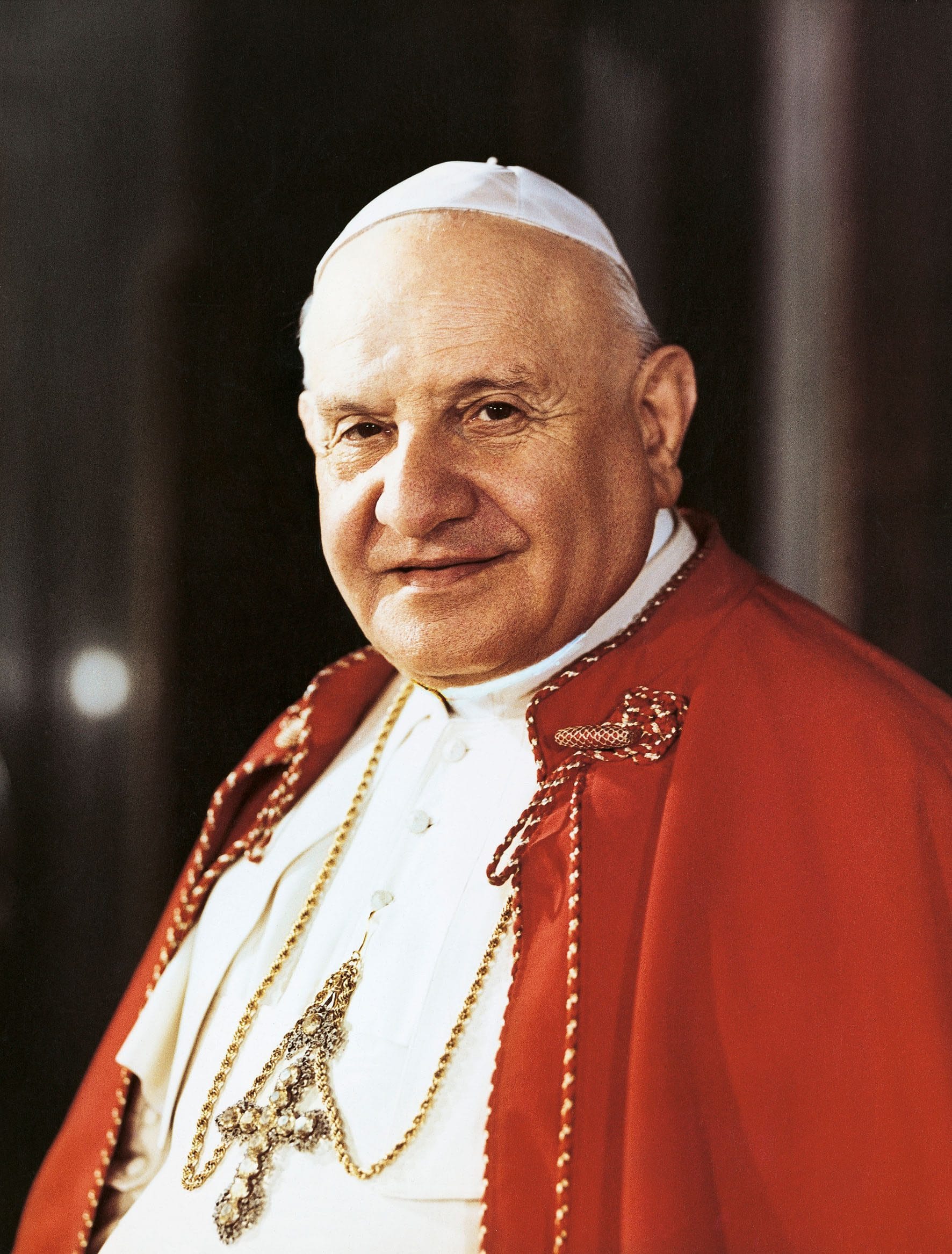Angelo Giuseppe Roncalli—Saint John XXIII—remains for many a figure of gentleness, closeness, and trust in Providence. His brief but luminous pontificate left a profound spiritual imprint: he was able to combine the simplicity of a country pastor with the gravity of a Church leader, opening paths of dialogue and mercy. The following text aims to offer a meditation on his spiritual life, his actions, and his words, and to suggest avenues of contemplation inspired by his example.
The interior life: simplicity, prayer and humility
John XXIII is often described as a man of humble and regular prayer. His spirituality is rooted first and foremost in a simple daily practice: Mass, hours of prayer, and personal prayer. This constancy expressed for him a familiar relationship with God—not a search for extraordinary experiences, but a fidelity in ordinary gestures. To meditate on his life is to measure the spiritual value of smallness day after day: prayer is not a luxury reserved for solemn moments, but the breath that sustains the Christian in the simplicity of each moment.
His humility was not a false posture, but a deep disposition of the heart: he accepted his limitations, did not seek power, and recognized the superiority of God in all things. This provides a clear lesson: the spiritual path is often one of self-emptying, of a renunciation that is not tragic but liberating. Accepting human fragility means leaving room for divine mercy.
Mercy as a style of government and life
Shortly before the opening of the Council, John XXIII promoted a less rigid and more compassionate perception of the Church. For him, mercy was not a mere theological concept, but a concrete way of being. He liked to remind people that the door of the Church must remain open, and that the heart of the pastor must beat in time with human suffering. His famous invitation to kindness—"open the windows of the Church"—illustrates this desire to make faith accessible, not to confine believers to a language reserved for a few.
To contemplate his way of exercising ministry is to see how pastoral tenderness and concern for the little ones transform doctrine into a living presence. Mercy is understood here as a dynamic: it does not deny the truth, but presents it in the form of a solicitude that heals and liberates.
Joy and Humor: Faces of Charity
John XXIII carried a simple and infectious joy. His humor—often discreet, never mocking—highlighted a profound truth: the Christian faith is a joy that sustains in adversity. His way of smiling and sharing kind words heralded a reassuring goodness. Contemplating this character trait invites us to recognize joy as the fruit of a life centered on God: prayer and trust produce a serenity capable of overcoming trials.
It is important to contemplate how cheerfulness and kindness work together: John XXIII's humor was not an escape, but a way to reach out to others, to relax tense hearts, and to open a space of trust where the word of God could be received.

Attention to the poor and to small things
A central aspect of his spirituality was his attention to the poor and his concrete gestures of charity. His visits, his warm words to the marginalized, his concern for workers and the sick speak of an incarnate theology. For John XXIII, presence with the little ones was a liturgical act: serving the most destitute was to adore Christ in his poor face.
Contemplation of these gestures leads to an embodied spirituality: prayer must translate into acts of service, liturgy must produce social transformation, and charity must inhabit daily gestures. Thus, holiness resides not only in great public actions, but in humble decisions to care.
The Second Vatican Council: a spiritual opening
The most famous act of his pontificate—the convening of the Second Vatican Council—can be read from a spiritual perspective: more than an institutional reform, it was an act of trust in the Spirit. John XXIII invited the Church to see itself with a gaze of mercy, to recognize itself as a people on the move rather than an immobile structure. His phrase "open the windows" reflects a spirituality of welcoming new air, of the light that penetrates closed spaces.
To contemplate this gesture is to contemplate a pastor's capacity to listen to the movement of the Spirit in history. The Council was an invitation to renew hope: to trust in believers, in the laity, in culture, without renouncing the foundations of faith. Spiritually, this means inhabiting the tension between fidelity and dialogue, between permanence and reform.
The Universality of Peace: A Prayer for Humanity
John XXIII pleaded for peace with astonishing force. His prayer for peace, his exhortation to political leaders, his encyclical Pacem in Terris (although promoted by his successor) are rooted in his heart as a universal pastor. He never reduced the Gospel to a word internal to the Church: the call to peace is a call to all humanity.
From a contemplative perspective, this reveals a cosmic spirituality: faith opens itself to human fraternity, recognizing that the dignity of each person is a theological locus. His prayer for peace invites inner silence: contemplating the possibility of a reconciled world is already a prayer, an act of hope that engages both the heart and action.

The Pastoral View of Truth: Tenderness and Integrity
John XXIII made no concessions to the truth, but loved it with gentleness. He taught that the truth must be proclaimed with respect, taking into account human limitations. His pastoral method emphasizes the way in which the faith is transmitted: the word of doctrine is effective only if it is accompanied by listening and understanding.
This attitude proposes a spirituality of listening: paying attention to the other, suspending certainty to hear the suffering, to see the story of life. Truth thus becomes an encounter rather than a simple statement. Contemplating this way of being is learning to bear the truth in patience and love.
The symbolism of gestures: small actions, big meaning
John XXIII knew how to express profound things through simple gestures. His small attentions—writing letters, kissing a priest's hand, greeting strangers—had the weight of a daily sacrament. Each gesture expressed a theology: the closeness of the pastor, the dignity of the person, the openness to encounter.
Christian meditation can draw inspiration from this: mundane actions, if done in a spirit of service and prayer, become signs of God's presence. Holiness takes the form of continuous attention, of love expressed in everyday life.
Trust in Providence and renunciation of anxiety
John XXIII displayed a strong trust in Providence. In personal trials and international crises, he chose prayer and trust over anguish. This attitude was not naiveté, but a firm assurance that God guides history. It invites Christians to place their fears in a broader perspective: to live without neglecting responsibility, but without being dominated by terror.
To contemplate this trust is to learn the art of serene detachment: to work for the good, while placing the results in God's hands. Inner peace is born from this alliance between human effort and trusting faith.

Holiness in Fragility: Consolation for the Weak
John XXIII often spoke gently of human fragility. His holiness was not that of an invincible hero, but of a man familiar with weakness. For the suffering believer, this example is consoling: holiness is accessible to those who know they are fragile and who seek the presence of the Lord. Faith then becomes refuge and light.
To meditate on this aspect of one's life is to allow the weak to recognize that they are loved. Divine grace transforms weakness into a place of encounter: where man is limited, the goodness of God can act.
Spiritual Portrait: Some Words and Gestures to Ponder
- Daily prayer and Mass as a source of strength: imitate his constancy.
- Kindness in speech and joy: cultivating a word that consoles.
- Concern for the poor: making charity a liturgical act.
- Openness to the world and welcoming new things: letting the Spirit renew.
- Trust in Providence: act without anxiety, entrust the fruits to God.
These elements form a guide for the spiritual life inspired by John XXIII: they do not require spectacular acts, but daily consistency, a gaze always turned towards God and towards our brothers and sisters.
Spiritual exercises inspired by John XXIII
Here are some simple contemplative practices to experience:
- Morning Silence (10–20 minutes): Before activities, remain in silence, invoke the Spirit, pray for peace and for the poor.
- Prayerful reading of a short text: choose a passage from the Gospels or the words of John XXIII; read slowly, let a word or phrase resonate, then remain silent.
- Daily act of mercy: a concrete gesture (calling a lonely person, helping a neighbor, giving to the needy), carried out in the presence of God.
- Availability Day: one day per month without excessive programming, left for meeting and prayer, to welcome the unexpected.
- Prayer for Peace: Every evening, offer the world's concerns in an inner prayer, confident that even if small, this gesture joins universal hope.

John XXIII and the Liturgy of the Heart
Pope Roncalli had a deep reverence for the liturgy as a source of interior life. His vision was not one of formal rigidity, but an appreciation of the liturgy as a space where the community unites to receive grace. To contemplate this attitude is to rediscover the Mass as the center of spiritual life: there, the believer learns humility, gratitude, and self-offering.
Limits and Criticisms: Humility in the Face of History
Even in contemplative meditation, it is necessary to recognize limitations: John XXIII did not solve all the Church's problems or anticipate all the consequences of the Council. But his spirituality remains a benchmark: he introduced a way of looking that invites listening and trust. The recognition of historical limitations reinforces the human dimension of his holiness: he was a humble instrument of God, not an omniscient master.
Spiritual Heritage and Call for Today
John XXIII's legacy is multifaceted: simplicity, mercy, the ability to open one's heart to the world, and joy. For our time, often tense and divided, his example offers a path: to encounter others without fear, to proclaim the truth with gentleness, to serve the poor as the presence of God. His call for peace remains relevant today: it is a reminder that faith must lead to reconciliation.

Conclusion: A Final Meditation
To contemplate the life of Saint John XXIII is to see a life rooted in prayer and turned toward love for one's brothers and sisters. His holiness is not presented as an unattainable model, but as a practicable path: daily fidelity, pastoral tenderness, trust in Providence. May his memory inspire everyone to cultivate gentleness, to love in truth, and to work for peace. In the silence of prayer, take up his words, imitate his actions, and ask for grace with an open heart: thus his spiritual presence among us continues.



